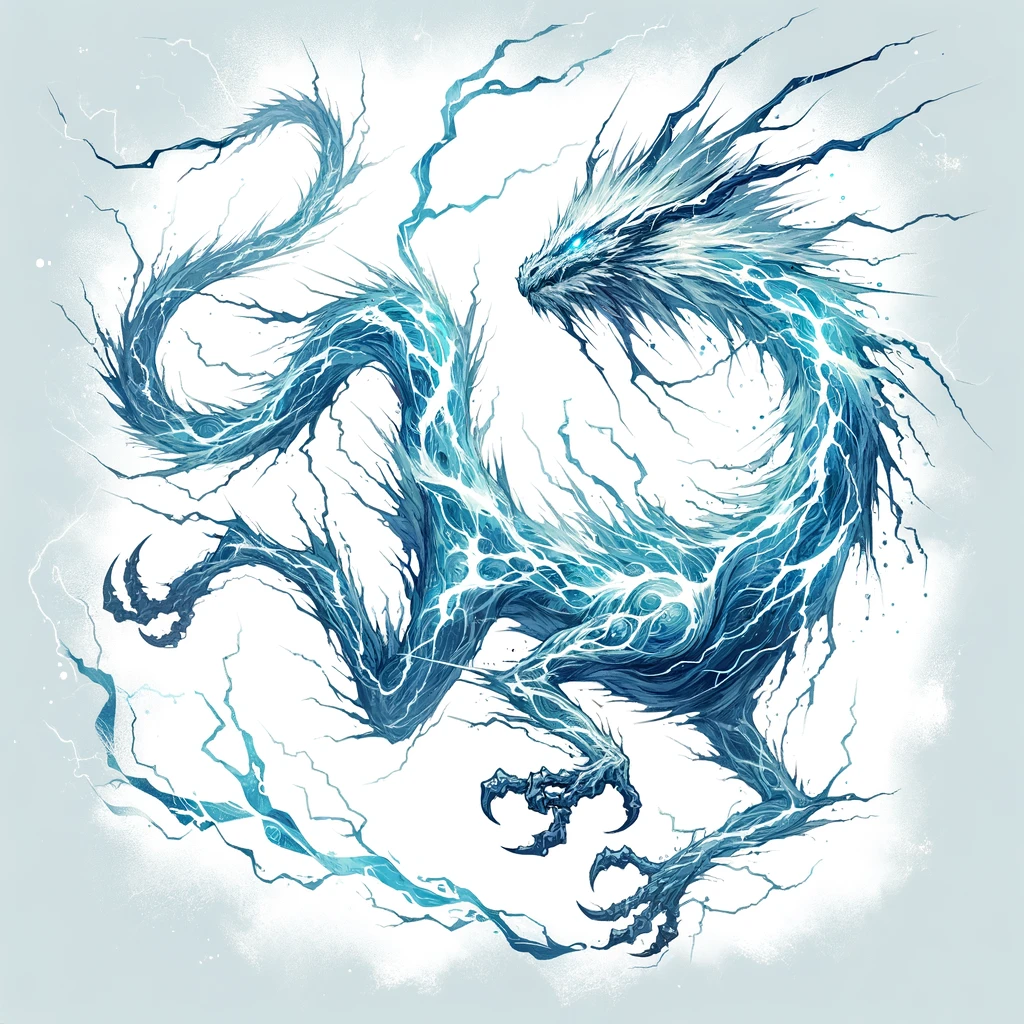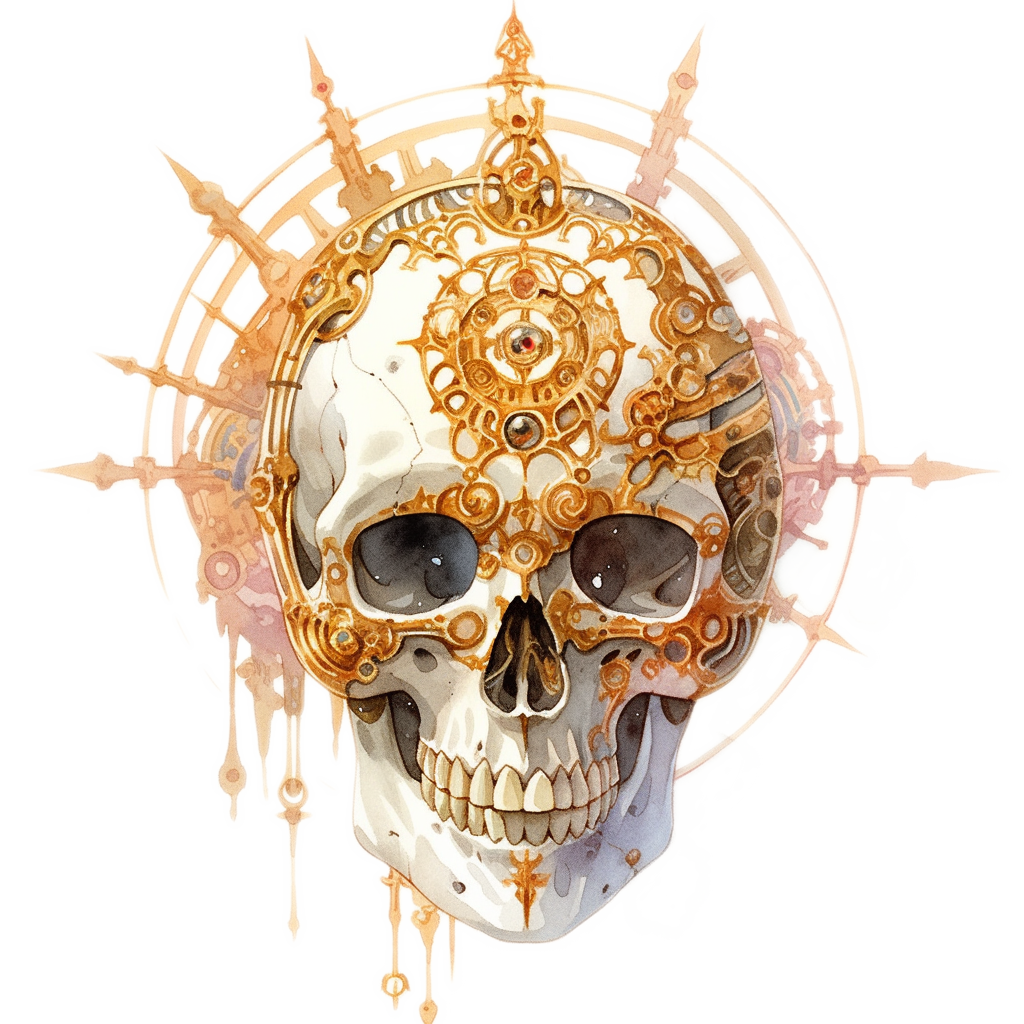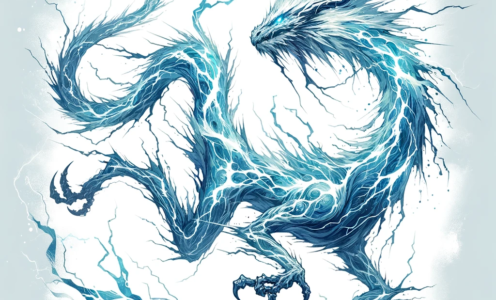Thunderstorm Dragon
Also known as lightning dragons, electric dragons
| CLIMATE/TERRAIN: | Quasi-Elemental Plane of Lightning, storms, thunder clouds |
| FREQUENCY: | Very Rare |
| ORGANISATION: | Solitary |
| ACTIVITY CYCLE: | Any |
| DIET: | Special |
| INTELLIGENCE: | Genius (17-18) |
| TREASURE: | See below |
| ALIGNMENT: | Any (primarity Neutral) |
| NO. APPEARING: | 1 (2-5) |
| ARMOUR CLASS: | -5 |
| MOVEMENT: | 12, Fly 35 (C), Jump 3 |
| HIT DICE: | 17 (base) |
| THAC0: | 4 (at 18 HD) |
| NO. OF ATTACKS: | 3+ special |
| DAMAGE/ATTACK: | 2d10 / 2d10 / 5d12 |
| SPECIAL ATTACKS: | See below |
| SPECIAL DEFENCES: | See below |
| MAGIC RESISTANCE: | See below |
| SIZE: | G (50′ base) |
| MORALE: | Fanatic (17-18) |
| XP VALUE: | See below |

Stormy and with tempers as quick as greased lightning (pardon the pun), thunderstorm dragons are one of the more dangerous catastrophic dragons to cutters caught unprepared. They are often seen flitting (if something of their gargantuan size can flit) among the brilliant flashes of lightning that occupy the Quasi-elemental Plane of Lightning.
Appearing similar to blue dragons with crackling lightning dancing from their scales, they prove to be an intimidating sight. They are surrounded by a soft light which grows in intensity as they become angry. An extremely mad dragon may become bright enough to blind a berk. They emit a barely audible rumble that increases in volume proportionally to the brightness of the light. The sound, however, never posses a serious threat to damaging ears.
Thunderstorm dragons speak their own tongue and one common to all elemental dragons. When they are born, they have a 13% chance to speak the language of any sentient creature. This chance increases by 4% per age category.
COMBAT: Thunderstorm dragons like to take an offensive approach to combat, employing whatever means they have to eradicate opponents. They rarely flee from combat, even if they are gravely injured. Their penchant for destruction has been described by the lightning archomental Ty-H’kadi as ‘charming’.
BREATH WEAPON/SPECIAL ABILITIES: A thunderstorm dragon’s breath weapon is a 5′ wide stroke of lightning that streaks 100′ in a straight line. This bolt inflicts double damage to creatures wearing metal armour or carrying more than 30 lbs. of metallic materials.
- Thunderstorm dragons cast spells and use their magical abilities at 14th-level plus their combat modifiers.
- Any AC bonus gained from metal armour is negated when fighting a thunderstorm dragon. If a metal shield is used, the AC bonus from that is negated as well. If a thunderstorm dragon is struck by a metal weapon, the wielder is shocked as if she had just been attacked by the thunderstorm dragon’s innate shocking grasp ability.
- When reduced to less than 1/4 of their maximum hit points, thunderstorm dragons will become so angry and glow so brightly, that all who look at them must save vs. spell or be blinded for 1d10 rounds. Those who pass the save may look at the dragon as they please.
- Thunderstorm dragons are born immune to energy draining, blindness, and electricity. They are born with the innate ability to use shocking grasp at will.
- As they age, they gain the following additional abilities: Young: Lightning bolt three times per day. Juvenile: Thunder staff three times per day. Adult: Chain lightning three times per day. Mature Adult: Wall of lightning (similar to wall of fire but with lightning instead of fire) three times per day. Very Old: Summon the storm (a version of control weather which always produces an intense lightning storm) three times per day.
HABITAT/SOCIETY: Thunderstorm dragons prefer to remain on their home plane, but occasionally make jaunts onto other planes if only to reproduce. Storm giants seem to have a particular liking of the creatures, as do many invokers. It is believed that first thunderstorm dragons were made from blue and bronze dragons, who allied with Ty-H’kadi.
Thunderstorm dragons have the greatest chance of all catastrophic dragons to have a moral bend, with an equal (45%) chance of being good or evil. The rest (10%) are morally neutral. This tendency is offset by a low ethical deviation, with only a small number being lawful or chaotic (5% chance of either). The others (90%) are ethically neutral.
ECOLOGY: Thunderstorm dragons sustain themselves on electricity. They seem to be able to gain small amounts of natural electricity from anywhere they are, so it’s near impossible to starve them outside of a vacuum (unless the screed surrounding anti-energons turns out to be true). They draw electricity towards themselves, often leaving a “tunnel” behind them when travelling on the Quasi-Elemental Plane of Lightning. Canny adventurers have followed thunderstorm dragons through the plane to escape being hit with a nasty bolt of lightning. They can, however, hunt and consume appropriately sized creatures, and will do so when they are still wyrmlings or have been injured.
When comes the time for a thunderstorm dragon to reproduce, it seeks a vortex or a portal to another plane. Once there, it begins to draw storm clouds around itself, until it is cloaked in a gargantuan storm cloud. A dragon in such a storm is even more frenzied than usual, it rains bolts of lightning down and destroys everything in its path. But there is a method to this madness. In places, where especially powerful bursts of lightning had struck the ground, large eggs appear buried under the layer of molten sand or dirt. From these eggs new thunderstorm dragons hatch. When they are sufficiently grown up, they search for powerful thunderstorms to get back to their home quasiplane. It is said that destroying objects of civilisation improves the odds of egg formation. For this purpose evil thunderstorm dragons prefer attacking settlements, while good ones may ally with powerful djinn or storm giant armies to channel their destructive needs into the service of good.
| Age Category | Body (‘) | Tail (‘) | AC | Breath Weapon | Wizard/Priest Spells | MR | Treasure | XP Value |
| 1 | 9-15 | 7-12 | -2 | 4d8+2 | Nil | Nil | Nil | 15,000 |
| 2 | 15-27 | 12-24 | -3 | 6d8+3 | Nil | Nil | Nil | 18,000 |
| 3 | 27-39 | 24-34 | -4 | 8d8+4 | 1 | 40% | 1/2H, S | 19,000 |
| 4 | 39-51 | 34-46 | -5 | 10d8+5 | 2 | 45% | H, S | 20,000 |
| 5 | 51-63 | 46-56 | -6 | 12d8+6 | 2 2 | 50% | H, S | 22,000 |
| 6 | 63-76 | 56-66 | -7 | 14d8+6 | 2 2 2 | 55% | H, S | 23,000 |
| 7 | 76-89 | 66-80 | -8 | 16d8+7 | 2 2 2 2 / 1 | 60% | H, Sx2 | 24,000 |
| 8 | 89-102 | 80-91 | -9 | 18d8+8 | 2 2 2 2 2 / 2 | 65% | H, Sx2 | 25,000 |
| 9 | 102-116 | 91-104 | -10 | 20d8+9 | 2 2 2 2 2 2 / 2 2 | 70% | H, Sx2 | 27,000 |
| 10 | 116-130 | 104-116 | -11 | 22d8+10 | 2 2 2 2 2 2 2 / 2 2 2 | 75% | H, Sx3 | 28,000 |
| 11 | 130-144 | 116-129 | -12 | 24d8+11 | 2 2 2 2 2 2 2 1 / 2 2 2 2 | 80% | H, Sx3 | 29,000 |
| 12 | 144-158 | 129-142 | -13 | 25d8+12 | 2 2 2 2 2 2 2 2 / 2 2 2 2 | 85% | H, Sx4 | 31,000 |
Source: John Kastronis, Jon Winter-Holt, Margarita. Canonwatch: this elemental dragon used to be simply called ‘lightning dragon’. We made a decision to combine those homebrew dragons with catastrophic dragons from 4e, who were named after natural disasters and other calamities.


